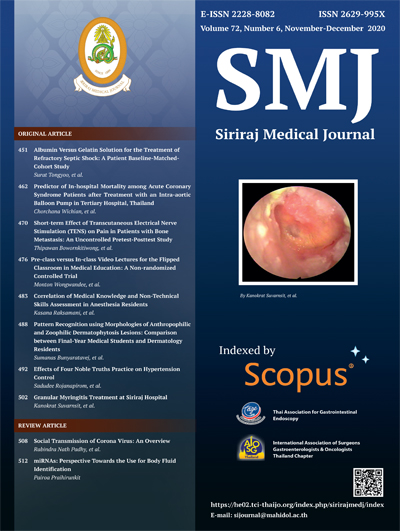Effects of Four Noble Truths Practice on Hypertension Control
DOI:
https://doi.org/10.33192/Smj.2020.67Keywords:
Blood pressure control, four noble truths, mobile webAbstract
Objective: To examine the effects of Four Noble Truths practice in controlling blood pressure with three-group comparison, involving a Mobile Web group, Guidebook group and usual care group in patients with stage 1 hypertension.
Methods: This randomized controlled trial was conducted in one university hospital setting. 145 participants were recruited into the study by randomized selection and were randomly assigning to the three groups. Of these, 45 participated as Mobile Web users, 50 as Guidebook users and 50 in the control group. The Mobile Web and Guidebook were developed using the guidance of the Four Noble Truths and received a phone call every two weeks for three times while control received a usual care. Then, the outcomes were measured including blood pressure and satisfaction at two-month after recruitment. The average blood pressure and satisfaction were compared by comparative descriptive statistic. Finally, analysis of covariance (ANCOVA) was used to analyze the covariate that may influence the outcomes with the post hoc analysis by Bonferroni.
Results: Participants who received Mobile Web and Guidebook had reduced their blood pressure more than those receiving usual care, with statistical significance (P < 0.05). It was found that blood pressures could be lowered to a maximum level of 5.09 ± 9.62mmHg within 8 weeks of treatment. Altogether, both groups were satisfied with healthcare services more than those receiving usual care, with statistical significance (P < 0.05).
Conclusion: The program could be applied to control high blood pressure in patients with stage 1 hypertension. The outstanding of this program could support overall difference in healthcare of each patient with fast efficacy.
References
1. World Health Organization. Global status report on noncommunicable diseases 2014. World Health Organization; 2014.
2. Kansui Y, Ibaraki A, Goto K, Haga Y, Seki T, Takiguchi T, et al. Trends in blood pressure control and medication use during 20 years in a hypertension clinic in Japan. Clinical and Experimental Hypertension. 2016;38(3):299-304.
3. Rangsin R, Tatsanawiwat P. The evaluation of DM type 2 and hypertension caring in hospital under Ministry of Public Health control: National Health Security office 2012.
4. Whelton PK, Carey RM. The 2017 American College of Cardiology/American Heart Association clinical practice guideline for high blood pressure in adults. JAMA cardiology. 2018;3(4):352-3.
5. Yoon SS, Gu Q, Nwankwo T, Wright JD, Hong Y, Burt V. Trends in blood pressure among adults with hypertension: United States, 2003 to 2012. Hypertension. 2015;65(1):54-61.
6. Tapp H, Dulin M, Plescia M. Chronic disease self-management. Chronic Illness Care: Springer; 2018. p. 29-40.
7. Brahmagunabhorn P, Evans B. A constitution for living. Bangkok: Dhammasapa Press; 2012.
8. Logan AG. Transforming hypertension management using mobile health technology for telemonitoring and self-care support. Canadian Journal of Cardiology. 2013;29(5):579-85.
9. Herdaningsih S, Muhtadi A, Lestari K. Consumption time of captopril influenced the outcomes of patients with stage 1 hypertension. Pharmacology and Clinical Pharmacy Research. 2017;2(1):11:74.
10. Erdfelder E, Faul F, Buchner A. GPOWER: A general power analysis program. Behavior Research Methods, Instruments, & Computers. 1996;28(1):1-11.
11. Cohen J. Statistical power analysis for the behavioral sciences: Academic press; 2013.
12. Saghaei M. An overview of randomization and minimization programs for randomized clinical trials. Journal of Medical Signals and Sensors. 2011;1(1):55.
13. Meidert A, Briegel J, Saugel B. Principles and pitfalls of arterial blood pressure measurement. Der Anaesthesist. 2019;68(9):637-50.
14. Anuruang S, Sindhu S, Wanitkun N, Sriyuktasuth A. The Effects of Empowering Care Program on Health Status and Health Service Satisfaction among Women with Hypertension. Thai Journal of Nursing Council. 2009;24(1):11-23.
15. Carey RM, Whelton PK. Prevention, detection, evaluation, and management of high blood pressure in adults: synopsis of the 2017 American College of Cardiology/American Heart Association Hypertension Guideline. Annals of internal medicine. 2018;168(5):351-8.
16. Dreher ML. Dietary Patterns and Hypertension. Dietary Patterns and Whole Plant Foods in Aging and Disease: Springer; 2018. p. 371-89.
17. Montrieux H, Vanderlinde R, Schellens T, De Marez L. Teaching and learning with mobile technology: A qualitative explorative study about the introduction of tablet devices in secondary education. PloS One. 2015;10(12): e0144008.
18. Blumenthal JA, Sherwood A, Smith PJ, Mabe S, Watkins L, Lin P-H, et al. Lifestyle modification for resistant hypertension: The TRIUMPH randomized clinical trial. American Heart Journal. 2015;170(5):986-94. e5.
19. Gu D, Yang X, Li X, Jain HK, Liang C. Understanding the role of mobile internet-based health services on patient satisfaction and word-of-mouth. International Journal of Environmental Research and Public Health. 2018;15(9):1972.
Downloads
Published
How to Cite
Issue
Section
License
Authors who publish with this journal agree to the following conditions:
Copyright Transfer
In submitting a manuscript, the authors acknowledge that the work will become the copyrighted property of Siriraj Medical Journal upon publication.
License
Articles are licensed under a Creative Commons Attribution-NonCommercial-NoDerivatives 4.0 International License (CC BY-NC-ND 4.0). This license allows for the sharing of the work for non-commercial purposes with proper attribution to the authors and the journal. However, it does not permit modifications or the creation of derivative works.
Sharing and Access
Authors are encouraged to share their article on their personal or institutional websites and through other non-commercial platforms. Doing so can increase readership and citations.















